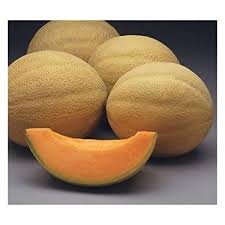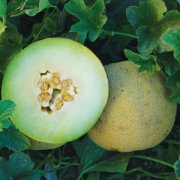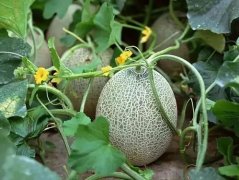Planting date and time of early-maturing hybrid melon varieties, matters needing attention and nursing care in the process of melon planting
Cantaloupe Watermelon Red Sweet & # 39th N early mixed cantalupo hibrido dulce Y precoz is an ideal area for short season. It can resist mildew and powder cream. The harvest is about 75 days. With plenty of sunshine, it is easy to sprout and grow. Mature for 75 days.
Few horticultural crops come close to the juicy sweetness of melons. Muskmelons (sometimes mistakenly called cantaloupe) has a reticulate yellowish-brown skin and salmon-colored meat. Melon-type melons include honeydew, smooth, white skin with light green flesh; casaba, pointing to the end of the stem, with yellow skin and white pulp at maturity; and Crenshaw, oval, with reticulate tan skin and pink flesh. Charentais melon, the real cantaloupe of France, with verrucous rib peel and sweet bright orange fruit. Because melons grow on ivy, they have a fair share of garden space. They also need a long and hot growing season, making it more difficult for them to grow in the north. Minimize problems by planting early-maturing varieties.
Planting date: late May
Migration date: early June
Plant species: fruit
Bloom cycle:
PH level: above 6.0,
Seed depth: 2. 2 inch
Plant space: 2-3 per mountain
Line spacing: 4-6 feet apart
Harvest date: 75 days
Regional requirements: preferably a long and warm summer
Fertilizer demand:
Light requirements: plenty of sunlight
Water requirement: sufficient water for grapevine growth; less fruit ripening
Soil demand: fertile, well-drained soil (high content of organic matter)
Disease problem: mold
Pest / insect problem: cucumber beetle
Solution: to prevent cucumber beetles, cover the line; remove when the female flower appears (the base of the female flower is swollen). Use pyrethroids to treat infections. In order to prevent mildew, maintain plant vitality and plant resistant varieties.
How to grow: if you start indoors, plant in a peat basin 3 or 4 weeks before the planned transplant. The warm season is 120 days or more, live outdoors or transplanted 2 or 3 weeks after the last frost. If not, plant 6 to 8 seeds in hills 3 feet apart, or 4 to 6 feet apart if not. After the threat of cucumber beetles and changing weather, thin plants are the strongest 2 or 3. Alternatively, separate the seeds by 1 foot, 5 to 6 feet in rows, thinning to 3 feet if latticed, and 4 to 6 feet on the ground. The migration uses the same spacing.
In spring, plastic sheets are covered with warm soil and then planted in plastic holes. In the south, once hot weather arrives, plastic is removed and organic mulch is used to keep the soil temperature uniform. To save space, provide support for grapevine climbing. If the melon hangs heavily, please support it with a net or pantyhose sling. If the plant is lying on the ground, put the melon on a butter bucket or plank to prevent pests. Keep the soil moist when grapevines grow and flowers are pollinating. When the fruit is ripe, it is watered only when the leaves wither at noon.
Harvest instructions: harvest when the size of the melon is 4-5 inches. The following are signs of ripening: melon, the stem is separated from the fruit, slightly pulled, leaving a round depression; honeydew, softening at the end of flowering (relative to the stem tip), the skin becomes milky white; Casaba, the skin softens at the end of flowering, the skin shows yellow stripes; and charentais, the fruit begins to turn yellow, softens or cracks at the end of flowering.

- Prev

What is the name of the green melon? What are the characteristics of Galia Siegel cantaloupes?
Galia Siegel Hami Melon, a green fleshy tropical melon with aromatic, sweet and crispy flesh. Always reliable in our trials and a favorite of our employees. Galia melons are developed by passing honeydew through cantaloupes to form a perfect circle
- Next

What are the characteristics of Xizhou honey? how does it look like cantaloupe? how much is the price per jin?
The autumn harvest of cantaloupe in Tuyugou Village, Shashan County, Turpan City, gradually entered the market in mid-September. After a bumper summer harvest, the autumn harvest is also about 3000 kg per 0.07ha. Turpan cantaloupes are sold in Guangzhou, Shenzhen and Shanghai. Among them, Xizhou honey variety
Related
- A course of planting techniques and methods on how to grow carrots
- How to plant the latest tulips?
- Is it better to pick tea in the morning or in the afternoon? When is the best time for tea to be picked? what is the third or fifth tea?
- Launch Yuanxiao Happy combination Haocha + Tea Yuan healthy Taste
- Penghu Tourism "Fireworks 20 Parade with You"
- 2022 West Lake Happiness holds "Digital Revitalization Voucher" and draws iphone13 and laptop.
- Banqiao Fuzhou social houses are designed to change start-up combined with police elimination to create a safe and livable environment
- The convenient measure of "mechanical weeding" in Xinbei has been abused and the Agriculture Bureau has imposed heavy penalties on the illegal land consolidation.
- Changgeng University Joins Hands with Four Memory Factories to Rescue Memory Talent Shortage
- The list of Taiwan's top 100 MVP managers is listed by the Director-General of the Farmers' Association of Sanxia District.

